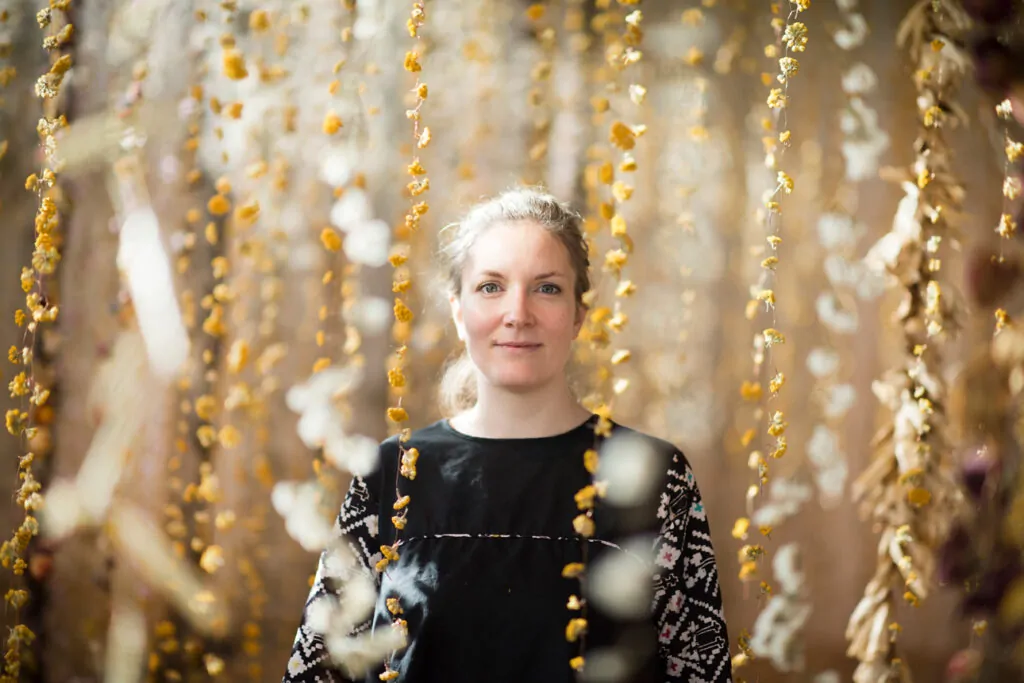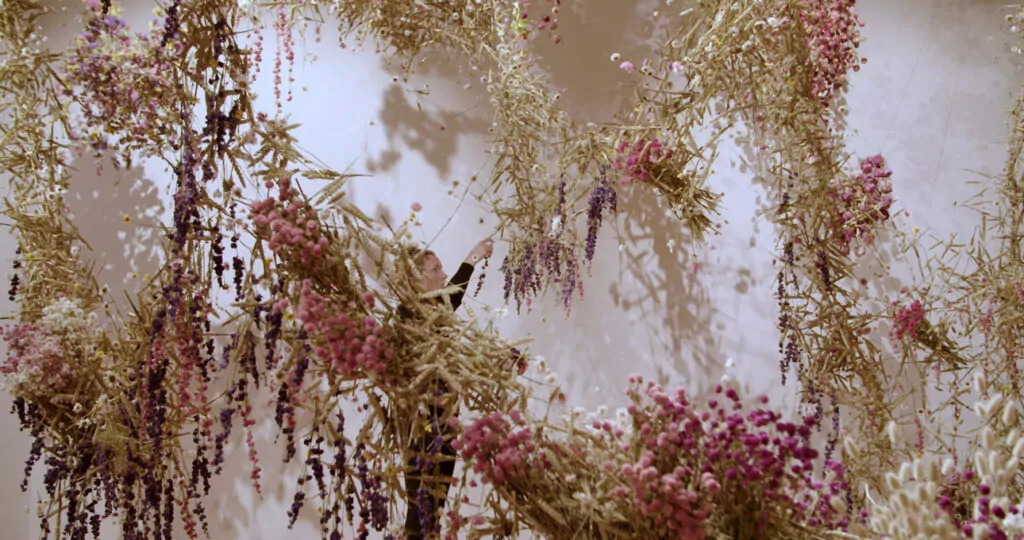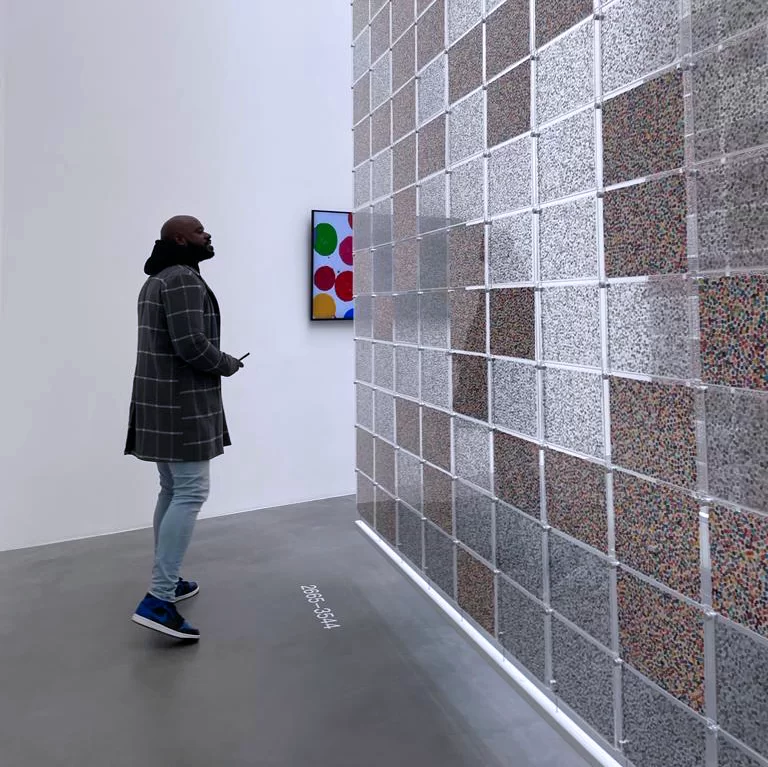The Sacred Stillness of Flowers: How Rebecca Louise Law Turns Fleeting Beauty Into Something Timeless
Flowers have long existed at the intersection of beauty and brevity—a soft symbol of time passing, love offered, or loss endured. Throughout art history, they’ve served not merely as decoration but as silent messengers, carrying everything from joy to sorrow, romance to regret. A single petal, after all, can whisper what words refuse to say.
And then there’s the scent—beyond pigment, beyond form. The velvet sweetness of a rose. The musky spice of an orchid. Fragrance becomes memory; memory, in turn, becomes ritual. Flowers don’t just mark time. They haunt it. They stretch it. They embed themselves in the architecture of the past.

By preserving the material, I create time and space for reflection on what we have been given on this earth and the fragility of it all.
Rebecca Louise
Few contemporary artists understand this as intimately as Rebecca Louise Law, whose installations transform once-ephemeral blooms into environments of reverence and reflection. Law’s practice embraces the physicality and resilience of nature’s most fragile offerings, elevating flora into something sacred. Her large-scale works—cathedrals of suspended botanicals—do more than adorn space. They sanctify it. Dried, preserved, and strung by hand, each flower becomes both a symbol of decay and an emblem of transcendence. These pieces offer what few moments in modern life allow: stillness.
At the Saatchi Gallery’s exhibition Flowers: Flora in Contemporary Art and Culture, Law’s installation La Fleur Morte (“The Dead Flower”) greeted me with haunting grandeur. Over 100,000 dried and preserved flowers floated in mid-air, their weight held by nearly invisible threads. The effect was less an artwork than an atmosphere—a suspended sky of petals under which I could only slow my breath and look up.
It was like walking into a cathedral of nature. The installation reached towards the vaulted ceiling of the Saatchi Gallery, a gentle canopy of colour and scent. The brittle materiality of each petal echoed mortality, yet the space felt truly alive. Law’s choice of decaying materials spoke to cycles of life and death—each element a whisper of impermanence. And yet La Fleur Morte never felt heavy. Its presence was dense, but its spirit light. Part chandelier, part prayer—caught between bloom and collapse, wonder and, yes, the silence.
“Tactility is central,” Law has said. And indeed, the experience of standing beneath her work is not only visual but embodied. Visitors don’t merely look; they dwell. The intimacy of the materials—many of them salvaged from the cut flower industry, the discarded elements, petals, stems, and dust—invites contemplation of the soul.
Let’s be clear: Law does not simply arrange flowers. She archives time. Her installations weave memory, mortality, and ecological mindfulness into one suspended form. Strand by strand, her work transforms galleries and public halls into sanctuaries—places to pause, to grieve, to give thanks; appreciating life in the moment, now.
Law’s practice is slow by design. It has taken her over two decades to gather her vast floral archive, much of it assembled by the hands of schoolchildren, local volunteers, and community groups. Her materials are often sourced from floral waste, yet the result is far from disposable. These are not decorations. They are living altars—reborn again and again in new forms and places.
For her upcoming installation Corridors, created for the S&DR200 festival, Law turns her attention to the symbolism of the railway. Once the iron spine of industrial expansion, the railway becomes in her hands a green artery—a passageway of memory, motion, and regrowth.
Inspired by the wild plants that flourish along train lines, Law explores the tension between ecological persistence and industrial impact. “We can’t slow time,” she says. “But we can think about what we do with it.”
That relationship between impermanence and preservation lies at the heart of her work.
“The flowers are dead,” Law notes. “But not decayed.” Each suspended bloom becomes a metaphor for survival—for breath held between moments. Even the dust from fallen petals is not discarded. It is collected. Catalogued. Cherished. “Nothing is wasted,” she says. “The flower, dust included, is my artistic medium.”
Law has exhibited and blessed spaces around the globe with her signature aesthetic, exploring the complexity of our human connection to nature and fostering a deeper appreciation of our world. She is a multidisciplinary artist, moving fluidly between mediums—painting, printmaking, weaving, glass, pottery, video—each one an extension of her reverence for the natural world.
In Law’s hands, a flower becomes a language; each bloom is placed like a brushstroke, each installation formed with intention. In Law’s world, a petal carries the weight of paint and organic form—asking us to slow down, to remember what we’ve forgotten: the land, the seasons, and our own humanity.
Your installations transform once ephemeral flowers into enduring, immersive experiences. How do you see the act of preserving and suspending these natural elements as a commentary on the human relationship with impermanence and memory?
Rebecca Louise Law: I see the installations as spaces that are suspended in time, offering viewers a moment to observe nature. Living material has an ephemeral nature that can often be too fleeting to have time to connect. By preserving the material, I create time and space for reflection on what we have been given on this earth and the fragility of it all.
Memories can be triggered by smell and being surrounded by nature. I have found that people are often brought back to childhood and memories of lost loved ones. My hope is that these works allow a connection to nature without the pressure of time, inspiring gratitude of all we have on this earth.

“Corridors,” your upcoming installation for the S&DR200 festival, explores the idea of railways as ecological connectors. What drew you to this metaphor of green corridors, and how did it shape your visual and conceptual approach?
Rebecca Louise Law: In 2022 I created an installation called The Journey, which first explored the idea of traveling through a natural corridor. I wanted to develop the concept further, inspiring Corridors. The metaphor makes me think not only of physical railway corridors, but also of life’s passage and our need to move quickly through nature.
Rail systems have created unique seed dispersion throughout the world and some plants that have established along the rail lines are extremely rare. The struggle between industry and nature continues and our consciousness of our collective impact affects the land and future generations. Moving through these green corridors is not enough. We need to pause, observe, and be present. We can’t slow down time, but we can think about what we do with it.

© Mark Jones
This installation is being created with the help of local community groups and the Preston Park Biodiversity Team. How does community collaboration influence your creative process—and the final meaning of the work?
Rebecca Louise Law: I like my works to be site specific and for me this includes the people of the land. I believe that consciousness comes from valuing both place and community. My installations invite local people to contribute, often from schools and community groups, creating an opportunity for neighbours to meet neighbours. Art becomes a platform of communication when we open it up. I like involving others in the process, sharing a sense of
ownership and starting relationships that can continue once the artwork has gone. Those relationships are the legacy.
Railways symbolise industrial progress, yet Corridors emphasises nature, regeneration, and ecological connection. How do you reconcile these forces in a single installation?
Rebecca Louise Law: We can’t change the past, but we can learn from it. It fascinates me that amidst destruction and pollution, unique plants have emerged along railways. The benefits of industrialisation have changed the way we live, not all positive.
But it is good to be reminded how strong nature is. This artwork is structurally designed to imitate the rail line, but looking at it closely is what matters. All of those local hands working together to show off all that nature provides us despite our destruction.
In La Fleur Morte at the Saatchi Gallery, you suspended over 100,000 dried flowers, inviting viewers into a vast, decaying floral landscape. What emotional or philosophical journey were you hoping visitors would experience as they moved through this dreamlike environment?
Rebecca Louise Law: Considering the flower beyond fresh and observing its intricate beauty and survival. Questioning our need for more and what we do with our time and money (nearly all these flowers are waste from the cut flower industry). Looking at the earth all it provides us and being grateful for that provision. Finally considering our neighbours, including, sharing and listening. The emotional connection is spiritual, deep in our souls a need to be with nature.

Saatchi Gallery, London, UK
©Rebecca Louise Law
Credit Matt Chung
The title La Fleur Morte evokes death, but the installation also feels deeply alive. How do you use decay and transformation as tools to spark reflection on life, survival, and rebirth?
Rebecca Louise Law: Preservation. It is what I do to hold on to time. To allow the viewer time to ‘be’. The flowers are dead but not decayed. They are being held before they go back to the earth. Flowers are a symbol of survival; we would not have many plants without flowers. They are an element within the cycle of life. In nature we wouldn’t have life without the death of a flower. As humans, we often take without noticing this exchange, we need to acknowledge it with gratitude. Without plants we would not exist either.
You’ve spoken about “holding time” in your work—preserving a bloom beyond its natural lifespan. What does this idea mean to you, and how do you think it changes how we relate to nature’s temporality?
Rebecca Louise Law: It is slightly fantastical. I have loved the fantasy of pausing time. Creating a peaceful place to roll around in the flowers. The reality is harsh. When you really look at nature and its dangers. The way we abuse and overuse.
The amount we are losing daily through climate change and our inability to slow time. The artworks are so removed from reality that I believe they can challenge our relationship with natures temporality or at least give us time to acknowledge it. But within the fantasy we can be grateful, and I believe that positive process can help us to shift our lives into being more considerate of our choices.

Calyx, Kunsthalle Museum, Germany
You collected even floral dust while creating La Fleur Morte. What does this meticulous attention to every trace of the flower say about your philosophy of wholeness and sustainability?
Rebecca Louise Law: I have always collected the dust from my artworks. The flower, dust included, is my artistic medium. Nothing is wasted. I believe you can repurpose anything if you put time into it.
Much of your practice is rooted in slow, hands-on methods—drying, preserving, threading flowers one by one. How does this pace contrast with the world outside your installations, and what space does it create for reflection?
Rebecca Louise Law: I believe in the bigger picture. I didn’t start my art practice with 2 million flowers. I started it with 100 flowers. It has taken me over 20 years to preserve and collect enough material to sculpt and create colossal installations that capture a tiny part of the awe-inspiring nature we are surrounded by.
This has only been possible through sharing my practice with communities, with at least 1 million of those flowers being wired by hands all over the world. I am grateful to everyone that has contributed to this vast archive. In contrast with the world outside – my art has grown by letting go of control and inviting collaboration. The patience and care that goes into collecting and working with natural materials over many years makes each artwork even more special and unique.
With exhibitions from Stockton-on-Tees to the Saatchi Gallery, how do you balance the environmental impact of large-scale installation art with your commitment to sustainability and ecological mindfulness?
Rebecca Louise Law: My team is minimal; I rely on the institutions heavily. We plan efficiently, ensuring the materials travel directly from one artwork to the next. Reusing the flowers and re sculpting the flowers is essential for zero waste. We also add at least 10,000 locally grown or collected flowers to each artwork with the help of the local community. Nothing is brought in new, and we are conscious of only collecting waste flowers or locally grown.

If your art is about capturing and preserving fleeting beauty, what do you hope future generations will remember or carry forward from your work?
Rebecca Louise Law: I hope that my work is not seen as merely an archive of flowers from the past. I want the future generations to acknowledge the artworks as gratitude for all we have and realise what we can do with what can be seen as ‘waste’.
When I first started my practice, the dried flower was seen as dead and waste. Already within 20 years this has changed into a valuable form. Flowers are a universal language that I have just scratched the surface of. Future generations can take this further. I believe flowers have the potential to communicate with every person on earth.
Your work moves between the deeply personal and the universally ecological. How would you define your philosophy of art—not just as a practice, but as a way of living and relating to the world around you?
Rebecca Louise Law: Art is my way of communicating. I see and sculpt in 3D. I see my art practice as a mirror to my mind and all I am concerned about. I want the fantasy, To lay down peacefully in the flowers. For as long as I am able, I will make these fantastical spaces, a place to connect spiritually.
But I would like this catalyst to trigger the deeper questions within. The artworks say so much more than what is on the surface. Are we valuing this earth and humanity? Can we use what we have in front of us? How much more do we need? Can we grow our own?
Do we know our neighbours? Could we share? Could we put down the phone and fill that time with repurposing, growing and sharing a cup of tea with a neighbour? I want art to be understood as a way of life, a way to communicate and for so many others to see that this is possible.
S&DR200 runs until November 2025 at various locations across County Durham and Tees Valley, UK, where you can experience Law’s latest piece, Corridors.
©2025 Rebecca Louise Law




